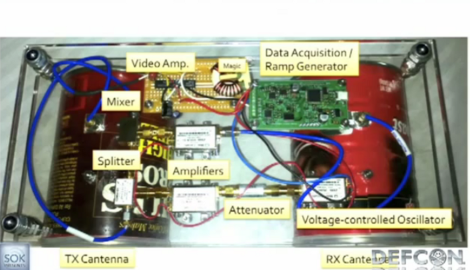How we missed this one is anybody’s guess, but one of the presentations at DEFCON last year covers a DIY radar build. [Michael Scarito] talks about the concepts behind radar, and then goes on to show that it’s not too hard or expensive to build a setup of your own. We’ve embedded his 45 minute talk after the break.
The two large pieces of hardware above should look familiar. They’re descendents of a favorite hacking project, the cantenna. The can-based long-range antenna is most popular with WiFi applications, but we’ve seen it used for Bluetooth as well and it’s not surprising to see it here. The rest is a lot of sensing hardware and enough math crammed into the coding to make your ears droop.
If you make it far enough (exactly 39 minutes into the talk) [Michael] shares some links for more information on the build. We think living vicariously is enough for us, but if you manage to build your own setup don’t forget to post a project log!
[via Dangerous Prototypes]

















I’m curious if some of the TV SDR hardware (http://hackaday.com/2012/04/16/playing-air-traffic-controller-with-software-defined-radio/) could be used for this application. Seems like standardizing the hacking community around a cheap high sample rate ADC like above could be a more modern alternative to all the sound card oscilloscopes for DSP projects.
This is exactly what I was looking for. Now I just need to eat some Pringles….
that’s also what I thought but later I saw the price :-(
excellent project, really good!
Or a lot of coffee
Really good bro !!
radar is not hard, in fact plans for suck a thing has been around in the ARRL handbook for over 20 years now.
Real hackers own the ARRL handbook, Older versions and new ones are goldmines of information education and designs.
Oh yes! I own the 1947 ARRL handbook, and even a smaller ARRL handbook, blue.
One thing about the RADAR though, I think in the United States, even hobbyist builds are questionable in the legal sense, I am not sure though. For example, when you sample chips from microchip, it asks if you are going to use the chips in any RADAR or missile items, and you are prohibited from doing so, if my memory serves me correctly. Anyone has any ideas about this?
If you watch the video he states this radar works in the 2.4Ghz ISM band with a 10mw tx power.
That question from Microchip and other mfrs is generally related to export control and arms trade regulations AFAIK.
They want to know you’re not going to build weapons or military hardware (i.e., hardware to be sold to an actual military group) with their stuff, because that opens them up to a lot of paperwork and potential liability.
I can’t think of any reason it would be illegal to build or own your own personal radar if you’re not using it on a prohibited weapon.
It might be illegal to operate that radar if you don’t have the proper radio license and/or transmit with too much power.
There are a few bands that are able to be used, the ISM bands. Like 450KHz and 13.56MHz. These are typical RF frequencies used in industrial equipment.
I have a 2.5kw, 450KHz rf supply for my sputtering system, since it is in the ISM band I don’t have to worry about a license as it is basically a big transmitter.
2.4ghz falls under this so the radar is perfectly legal.
You RF Sputtering system will be of commercial manufacture and therefore Type Approved which is why it’s license free.
Homemade equipment however is not Type Approved so it cannot be license free,
(unless it’s covered by a Ham license).
Next step, DIY radar controlled cruise control for cars.
I want that to patch into the cruise control on my 1995 Buick so it’ll automatically keep a set distance from the nuts who can’t keep their speed steady.
I’ve been thinking about this for a bit. I think a dynamic cruise control could be done much more simply than this general purpose radar. Get one of those toy store baseball speed guns and stash the bits behind the bumper, take the speed signal going to the display and feed it into an arduino set up as a PID controller to minimize the relative speed, with the output going to the existing cruise control.
The only problem would be to control the brakes in case they brake rapidly (e.g. deer or other animal in the road). Plus I wonder if it’d trigger one of those anti-radar sensors some people have installed, which cause people to freak out and slow down.
that being said, I’d like to see cars that are able to implement that
The project looks disturbingly like an improvised bomb…
Geez you sound like my mom. “You better not be building bombs in there!” Lots of electronics projects look like bombs.
I initially thought the same thing “That looks familiar…I remember an IED boobytrap that looked like that once”
Michael Scarito was talking about a board he was working on which could do both timing and ADC. Any news on this?
excellent and exciting work, but can you use a mobile phone transmitter and receiver?
How to make radder display
What I the distance range of this radar ?
I’d like to build this as I lost my Quad Copter which is made mostly of Carbon Fibre, Aluminium and copper. Would this work to find out which tree i lost it in ? Or potentially find it on the ground in heavy bush ?
Hi Michael i could not resist using(copying) your “Who am I” XXXXX /Everything else when Necessary(this part) – Thank you